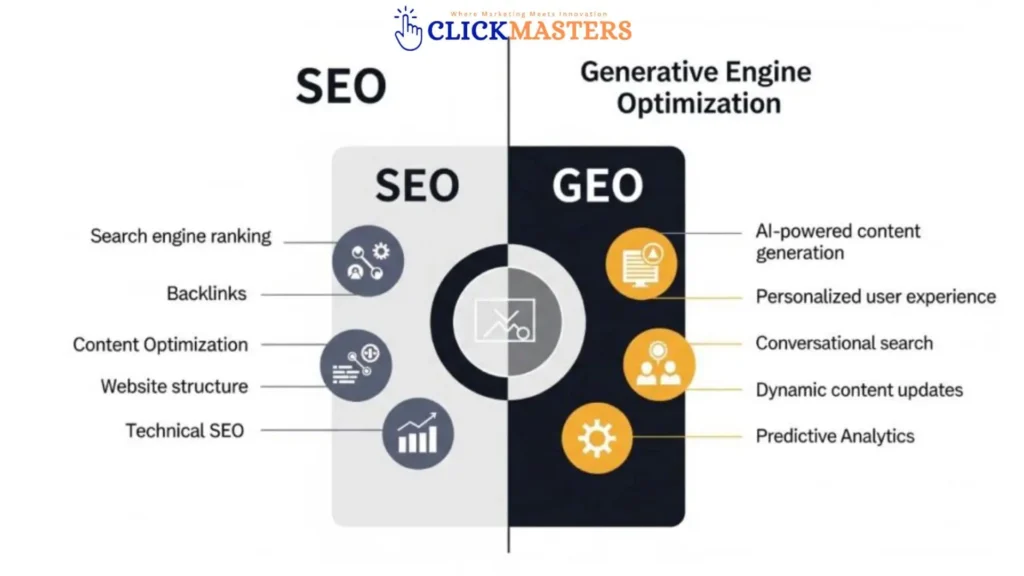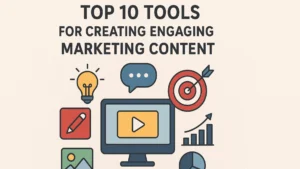Learn AEO vs GEO vs VEO — the 3 pillars of future SEO. Discover how AI, voice, and answer optimization can boost your search visibility.
Table of Contents
The digital marketing landscape is experiencing a drastic change. Traditional Search Engine Optimization (SEO) alone is no longer that important to maintain visibility in today’s rapidly evolving search ecosystem.
Search Engine Optimization (SEO) is no longer just about ranking on Google’s front page. With the evolution of search behavior and artificial intelligence (AI), we now see the rise of new optimization strategies: Answer Engine Optimization (AEO), Generative Engine Optimization (GEO), and Voice Engine Optimization (VEO). These three emerging pillars redefine how content gets discovered, displayed, and consumed.
Artificial Intelligence is helping users discover information. Three distinct optimization strategies have emerged as the backbone of modern digital marketing: Answer Engine Optimization (AEO), Generative Engine Optimization (GEO), and Voice Engine Optimization (VEO).
This comprehensive guide explores these three pillars of future SEO, providing actionable insights, statistics, and strategies to help businesses navigate the complex world of AI-driven search optimization.
The Current State of Search: Why Traditional SEO Isn’t Enough
The search landscape has completely changed. According to recent data, nearly 60% of Google searches ended without anyone clicking on a website in 2024 (DEVcomunity). This zero-click phenomenon highlights a crucial shift in user behavior; people increasingly expect instant answers rather than browsing through multiple links.
Moreover, organic search drove 53 percent of all e-commerce sessions in 2024, demonstrating that while search remains vital for business success, (kuble)the mechanisms of search visibility are evolving rapidly. Google processes over 5 trillion searches per year, and 53.3% of all website traffic comes from organic search (BrightEdge). Websites with strong SEO enjoy long-term, compounding traffic growth.
Limitations
- 64.8% of Google searches result in zero clicks (SparkToro).
- Featured snippets and AI results push organic listings below the fold.
The rise of AI-powered search engines like Google AI Overviews, ChatGPT, and Perplexity is fundamentally changing how users interact with search results.
Understanding the Three Pillars
1. Answer Engine Optimization (AEO): Optimizing for Direct Answers
Answer Engine Optimization focuses on creating content that directly answers user queries in a format that AI systems can easily extract and present. 58% of people use voice search to find local business information (Think with Google).
Unlike traditional SEO, which aims to drive traffic to websites, AEO prioritizes providing immediate value through featured snippets, knowledge panels, and AI-generated responses.
Key Components of AEO:
Structured Data Implementation AEO relies heavily on structured data markup to help search engines understand the content context. This includes schema markup for articles, FAQs, products, and local businesses. Properly implemented structured data increases the likelihood of content being featured in rich snippets and voice search results.
Question-Answer Format Content Creating content that directly addresses common user questions is fundamental to AEO success. This involves researching question-based keywords and structuring content to provide clear, concise answers. The “People Also Ask” section on Google provides valuable insights into related questions users are searching for.
Featured Snippet Optimization Featured snippets appear in approximately 19% of search queries, making them crucial for AEO success. Content should be structured with clear headings, bullet points, and numbered lists to increase the chances of being selected for featured snippets.
AEO Best Practices:
- Create comprehensive FAQ sections addressing common industry questions
- Use clear, descriptive headings that match search queries
- Implement structured data markup for all content types
- Optimize for long-tail, question-based keywords
- Provide concise, actionable answers within the first 150 words of content

2. Generative Engine Optimization (GEO): Preparing for AI-Generated Search
Generative Engine Optimization is the newest addition to the search optimization landscape, focusing on how content appears in AI-generated search responses. As AI tools like ChatGPT, Google Bard, and Perplexity become more prevalent, GEO ensures that your content is discoverable and properly attributed in AI-generated answers.
The Rise of Generative AI in Search
AI-powered search engines are revolutionizing how users find information. These tools don’t just index and rank content; they synthesize information from multiple sources to provide comprehensive answers. This fundamental shift requires a new approach to content optimization.
Key Components of GEO:
Authority and Expertise (E-A-T) Generative AI systems prioritize content from authoritative sources. Building expertise, authoritativeness, and trustworthiness (E-A-T) is crucial for GEO success. This involves creating high-quality, well-researched content authored by recognized experts in the field.
Citation-Worthy Content: Creating high-quality, well-structured content is the foundation of success for AEO, GEO, and VEO strategies. Businesses that invest in professional article writing and blog writing services are better positioned to provide authoritative, engaging, and SEO-friendly content. This not only helps capture featured snippets and AI citations but also builds trust with both search engines and users.
Contextual Relevance Unlike traditional keyword optimization, GEO emphasizes topical authority and contextual relevance. Content should comprehensively cover topics, addressing various aspects and related subtopics to establish topical authority.
GEO Best Practices:
- Develop comprehensive topic clusters around core business areas
- Create original research and publish industry statistics
- Build author profiles and establish thought leadership
- Ensure content is factually accurate and well-sourced
- Focus on creating cornerstone content that serves as an authoritative reference
3. Voice Engine Optimization (VEO): Capturing the Growing Voice Search Market
Voice Engine Optimization addresses the rapidly growing voice search market. With around 20.5% of people worldwide now using voice search as of 2025, representing a nearly 1% increase from the previous year, VEO has become essential for maintaining search visibility.
The Voice Search Revolution
Voice search behavior differs significantly from traditional text searches. Insider Intelligence predicts that 72% of U.S. adults will routinely use voice assistants like Alexa, Siri, and Google Assistant for information retrieval by the end of 2025. This shift emphasizes the importance of optimizing for conversational queries and natural language patterns.
Key Components of VEO:
Conversational Keywords Voice searches are typically longer and more conversational than text searches. Around 80% of voice searches are predicted to be conversational by 2024, requiring optimization for natural language patterns and question-based queries.
Local Search Optimization Voice search has a strong local intent. “Near me” and local searches make up 76% of voice searches and are expected to grow as more people use voice search to find local businesses. This makes local SEO crucial for VEO success.
Fast-Loading Pages Voice search results prioritize speed. Voice search result pages load much faster than the average page, which takes about 8.8 seconds to load, with voice results loading in approximately 4.6 seconds.
VEO Best Practices:
- Optimize for question-based, conversational keywords
- Create content that answers “who,” “what,” “where,” “when,” “why,” and “how” questions
- Ensure fast page loading speeds (under 3 seconds)
- Implement local SEO strategies for location-based searches
- Use natural language in content creation
- Optimize for mobile devices, as most voice searches occur on mobile
The Interconnected Nature of AEO, GEO, and VEO
While AEO, GEO, and VEO are distinct optimization strategies, they share common foundations and work synergistically to improve overall search visibility. Understanding their interconnections is crucial for developing a comprehensive search optimization strategy.
Shared Elements:
User Intent Focus: All three pillars prioritize understanding and addressing user intent. Whether optimizing for direct answers, AI-generated responses, or voice queries, the foundation remains the same: providing valuable, relevant content that meets user needs.
Content Quality and Authority: High-quality, authoritative content forms the backbone of all three optimization strategies. E-A-T principles apply across AEO, GEO, and VEO, emphasizing the importance of expertise, authoritativeness, and trustworthiness.
Technical Optimization Technical SEO elements like site speed, mobile optimization, and structured data benefit all three pillars. Fast-loading, mobile-friendly websites with proper markup perform better across traditional search, voice search, and AI-generated results.
Strategic Integration:
Content Strategy Alignment: Successful implementation requires aligning content strategies across all three pillars. This involves creating comprehensive content that addresses multiple search behaviors and query types while maintaining consistency in messaging and brand voice.
Cross-Platform Optimization Modern search optimization requires thinking beyond traditional search engines. Content should be optimized for various platforms and AI systems, ensuring visibility across the entire search ecosystem.
Key Differences Between SEO, AEO, GEO & VEO
| Feature | SEO | AEO | GEO | VEO |
| Main Goal | Rank on Google | Appear in snippets/AI answers | Be cited by chatbots | Show up in voice results |
| User Behavior | Click-based | Zero-click | AI-based responses | Voice commands |
| Format Focus | Keyword-rich content | FAQ/Q&A format | Long-form + sources | Local + short answers |
| Tools | SEMrush, Ahrefs | Schema.org, Answer the Public | llms.txt, AI Rank tools | Google Voice Search Tools |
Measuring Success: Key Performance Indicators
AEO Metrics:
- Featured snippet captures and impressions
- Position zero rankings
- Knowledge panel appearances
- Click-through rates from enhanced results
- “People Also Ask” feature appearances
GEO Metrics:
- Citations in AI-generated responses
- Brand mentions in AI tools
- Authority score improvements
- Topical authority rankings
- Expert author recognition
VEO Metrics:
- Voice search ranking positions
- Local voice search visibility
- Mobile search performance
- Page loading speed metrics
- Conversational query rankings
Tools and Resources for Implementation
Essential Tools:
SEO Platforms:
- SEMrush: Comprehensive SEO toolkit with voice search tracking
- Ahrefs: Advanced keyword research and content analysis
- BrightEdge: Enterprise-level SEO platform with AI insights
- Screaming Frog: Technical SEO auditing tool
Voice Search Tools:
- SEMrush Voice Search Analytics
- BrightEdge Voice Search Optimization
- Rank Ranger Voice Search Tracker
- SearchEngine.io Voice Search Monitor
AI and Content Tools:
- Clearscope: AI-powered content optimization
- MarketMuse: Topic modeling and content planning
- Surfer SEO: Content optimization for search engines
- Frase: AI-powered content research and optimization
Free Resources:
- Google Search Console: Essential for monitoring search performance
- Google Trends: Understanding search behavior and trends
- AnswerThePublic: Question-based keyword research
- Also Asked: People Also Ask data extraction
Future Trends and Considerations
Emerging Technologies:
The search landscape continues evolving with new technologies. Augmented reality search, improved natural language processing, and more sophisticated AI models will further transform how users discover information. Staying ahead requires continuous learning and adaptation.
Algorithm Updates:
Google and other search engines regularly update their algorithms to better serve user needs. These updates increasingly favor user experience, content quality, and technical excellence. Businesses must remain agile and adapt quickly to algorithm changes.
Multi-Modal Search:
The future of search includes visual, audio, and even augmented reality components. Optimizing for image search, video search, and emerging technologies will become increasingly important for maintaining visibility.
Privacy and Ethical Considerations
As search becomes more personalized and AI-driven, privacy concerns grow. Businesses must balance optimization efforts with user privacy, ensuring compliance with regulations like GDPR and CCPA. Ethical AI practices and transparent data usage will become competitive advantages.
Conclusion: Embracing the Future of Search
The evolution from traditional SEO to a multi-faceted approach encompassing AEO, GEO, and VEO represents a fundamental shift in digital marketing. Success in this new landscape requires understanding that search optimization is no longer about gaming algorithms—it’s about genuinely serving user needs across multiple touchpoints and platforms.
The businesses that will thrive are those that embrace this complexity, investing in comprehensive strategies that address all three pillars simultaneously. By focusing on user intent, content quality, and technical excellence, organizations can build sustainable search visibility that adapts to future changes.
Ready to Future-Proof Your SEO?
Need help implementing AEO, GEO, or VEO strategies?
Click Master Digital Marketing Agency specializes in cutting-edge SEO solutions tailored for the AI-first era.
Frequently Asked Questions (FAQs)
What is the difference between AEO, GEO, and VEO?
Answer Engine Optimization (AEO) focuses on optimizing content for direct answers in search results like featured snippets and knowledge panels. Generative Engine Optimization (GEO) targets AI-powered search engines that synthesize information from multiple sources to create comprehensive answers. Voice Engine Optimization (VEO) optimizes content for voice search queries, which tend to be more conversational and locally-focused.
How do I know if my content is optimized for voice search?
Your content is voice search optimized if it answers questions using natural, conversational language, loads quickly (under 3 seconds), includes local information when relevant, and targets long-tail, question-based keywords. You can test this by asking voice assistants questions related to your business and seeing if your content appears in responses.
What percentage of searches are now voice-based?
According to recent data, approximately 20.5% of people worldwide use voice search as of 2025, with this number steadily growing. Voice searches are particularly popular for local queries, with 76% of voice searches having local intent.
How can I optimize for featured snippets?
To optimize for featured snippets, structure your content with clear headings, provide direct answers within the first 150 words, use bullet points and numbered lists, implement structured data markup, and focus on question-based keywords. Content that appears in featured snippets typically provides concise, actionable answers to specific queries.
What is Generative Engine Optimization, and why is it important?
GEO is the practice of optimizing content for AI-powered search engines like ChatGPT, Google Bard, and Perplexity. It’s important because these tools are increasingly being used for information discovery, and they prioritize authoritative, well-sourced content when generating responses. GEO focuses on building expertise, authority, and trustworthiness (E-A-T) to ensure your content is cited by AI systems.
How do I measure the success of my AEO, GEO, and VEO efforts?
Success can be measured through various metrics: AEO – featured snippet captures, position zero rankings, knowledge panel appearances; GEO – citations in AI responses, brand mentions in AI tools, authority score improvements; VEO – voice search rankings, local voice search visibility, mobile performance metrics.
Can I implement all three strategies simultaneously?
Yes, and it’s recommended. AEO, GEO, and VEO share common foundations like high-quality content, technical optimization, and user intent focus. Many optimization techniques benefit all three pillars simultaneously, making integrated implementation more efficient than separate approaches.
What tools do I need to implement these strategies?
Essential tools include comprehensive SEO platforms like SEMrush or Ahrefs for keyword research and tracking, Google Search Console for performance monitoring, structured data testing tools, voice search tracking tools like BrightEdge Voice Search, and AI-powered content optimization tools like Clearscope or MarketMuse.
How long does it take to see results from these optimization strategies?
Results vary by strategy and implementation quality. AEO results (featured snippets) can appear within weeks to months, GEO results may take 3-6 months as AI systems learn to recognize your authority, and VEO results typically show within 2-4 months. Consistent, high-quality implementation is key to faster results.
Is traditional SEO still important with AEO, GEO, and VEO?
Yes, traditional SEO remains the foundation. Technical SEO, keyword research, content quality, and link building still matter significantly. AEO, GEO, and VEO are evolutionary extensions of traditional SEO, not replacements. They build upon solid SEO fundamentals to address new search behaviors and technologies.
How do I optimize for local voice search?
Local voice search optimization involves creating location-specific content, optimizing Google My Business profiles, using local keywords naturally in content, ensuring NAP (Name, Address, Phone) consistency across platforms, and creating content that answers local questions like “near me” queries.
What are the three main pillars of SEO?
The three main pillars are AEO (Answer Engine Optimization), GEO (Generative Engine Optimization), and VEO (Voice Engine Optimization) — covering direct answers, AI-generated results, and voice search.








